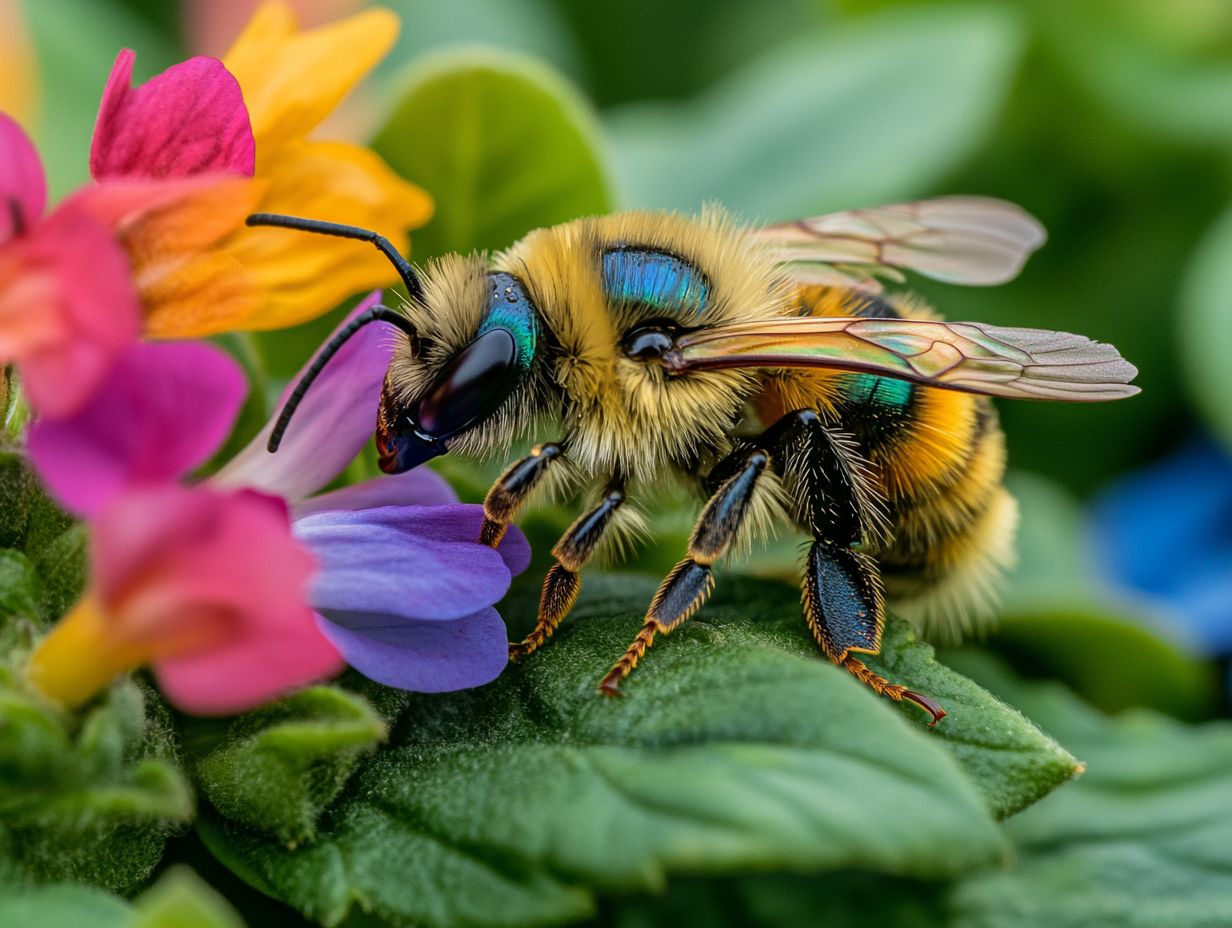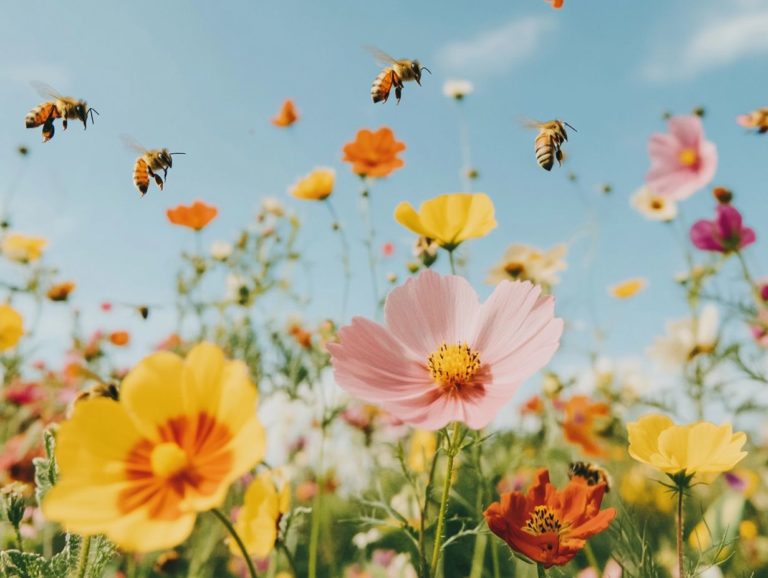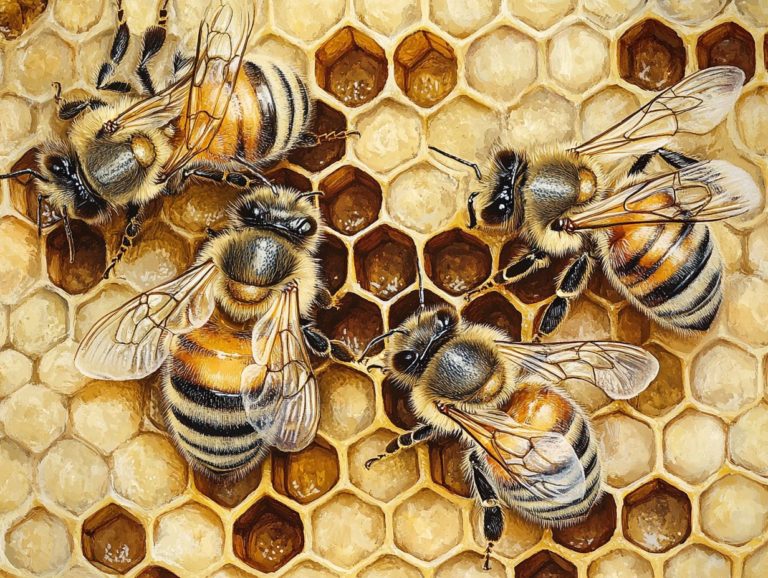5 Unique Traits of Mason Bees
Discover the unique world of mason bees (Osmia), the incredible solitary pollinators that work wonders in our gardens! These remarkable beings play an essential role in our ecosystems, often overshadowed by their more celebrated counterparts, honey bees (Apis). Their work as pollinators is crucial for maintaining plant diversity and ecological balance.
This article delves into five distinctive traits that elevate mason bees as exceptional pollinators. You ll learn about their solitary nature, gentle disposition, and penchant for nesting in existing spaces, such as mason bee houses or bee hotels.
Find out how they differ from honey bees (Apis), the advantages of inviting them into your garden, and the challenges they encounter, including habitat loss and climate change. Explore the intriguing world of mason bees and learn how you can contribute to supporting these vital pollinators within your community by creating an attractive mason bee habitat.
Contents
Key Takeaways:

- Mason bees are solitary bees, meaning they do not live in hives like honey bees.
- Mason bees are excellent pollinators, making them great for the health and productivity of your garden by enhancing pollination efficiency.
- Mason bees are non-aggressive and rarely sting, making them safe to have around children and pets.
1. Solitary Bees
Solitary bees, particularly Mason Bees (Osmia), are remarkable native pollinators that play a vital role in our ecosystems. Unlike honey bees (Apis), which thrive in hives, solitary bees like the blue orchard bee (Osmia lignaria) and red mason bee (Osmia bicornis) prefer to operate independently. Their contributions to pollination are significant, especially for fruit trees and wildflowers.
Their unique nesting habits, primarily utilizing existing spaces such as hollow stems and wood, showcase their adaptability and highlight their importance in maintaining biodiversity. This term refers to the variety of life in an ecosystem and is crucial for its health.
These bees typically favor nesting in wood, reeds, or even the ground. They diligently collect pollen and nectar to provision their eggs. Identifying solitary bee species can be a fascinating endeavor, as there are over 20,000 species worldwide, each boasting distinct physical characteristics and behaviors.
Solitary bees do not produce honey or wax. Their solitary lifestyle encourages them to visit a wide variety of plants, including early-blooming flowers essential for their survival, like crocuses and willows. This specialization aids in plant reproduction and greatly enhances the health of various ecosystems, making these bees indispensable in agricultural productivity and biodiversity conservation.
2. Excellent Pollinators
Mason bees are exceptional pollinators, renowned for their remarkable efficiency and specific preferences for certain flowers. They are critical allies in the pollination of various fruit trees like apples and cherries, as well as native plants such as elderberry and huckleberry.
These tiny, solitary bees possess an extraordinary capability to pollinate nearly 2,000 flowers in just one day. Unlike honey bees, which tend to be more general in their flower choices, mason bees have a fondness for certain blooming plants, including fruit trees, willows, and various wildflowers.
Their role in the ecosystem is vital. Their effective pollination directly influences fruit set and yield in orchards, ultimately enhancing biodiversity and agricultural productivity. This impressive efficiency fosters the growth of fruits like apples and cherries and supports the maintenance of healthy ecosystems, promoting pollination across a diverse array of plant species.
Now that you know how unique mason bees are, let s explore what makes them such excellent pollinators. You can help these vital creatures by creating welcoming spaces in your garden, ensuring they thrive and continue their important work.
3. Non-Aggressive Nature
Mason bees are remarkable for their non-aggressive nature, making them the perfect companions for your backyard garden or urban space. Since they rarely sting, they pose little threat to you or anyone else nearby.
This calming demeanor is especially advantageous for gardeners and nature lovers who seek to promote pollination without anxiety. Interestingly, the female mason bees possess the ability to sting, but they seldom resort to it. Instead, they dedicate themselves to vital roles in nesting and pollinating flowers.
The males, on the other hand, are completely stingless, embodying a more docile and friendly character. This non-aggressive behavior creates a safer environment for you and enhances pollination in your garden, leading to significantly improved yields of fruits and vegetables.
By inviting these amazing bees into your garden, you become a champion of biodiversity, ultimately supporting plant health and the vitality of the entire ecosystem.
4. Nest in Pre-Existing Cavities

Mason Bees have fascinating nesting habits, favoring pre-existing cavities such as hollow stems, wood, and specially designed bee hotels often provided by companies like Crown Bees and Best Bees Company.
Within these cozy spots, they create brood cells, which are spaces for their young, meticulously separated by mud partitions. In these secure environments, the female bee diligently gathers nectar and pollen to fill each cell, ensuring her offspring have ample food once they hatch.
Those mud partitions are vital, protecting developing larvae from predators and pathogens. This creates safe, individual spaces for each bee and emphasizes the importance of mason bee conservation for their lifecycle.
By incorporating mason bee houses or bee hotels in your garden, you can significantly boost local biodiversity. These artificial habitats invite mason bees to flourish, enhancing the pollination of a diverse array of plants and leading to healthier gardens and thriving ecosystems.
5. Short Lifespan
Mason Bees have a relatively brief lifespan, with adults living just a few weeks. This highlights their efficient and focused lifecycle. During this time, the female mason bee laser-focuses on laying eggs and preparing brood cells.
Once she s fertilized, the female mason bee carefully lays her eggs in the meticulously crafted mud tubes. Each egg is supplied with a nourishing mixture of nectar and pollen for the developing larvae, emphasizing the ecological importance of these actions.
After hatching, those larvae feast on the food she provided before entering the pupal stage (the time when larvae transform into adult bees). Various factors, such as weather conditions, the availability of nesting sites, and competition for resources, can drastically impact their short lifecycles.
A prolonged cold spell or a dip in flower availability can cut into their pollination time, affecting not just their survival rates but also the health of the ecosystems that rely on them.
How Do Mason Bees Differ from Honey Bees?
Mason Bees stand apart from honey bees (Apis) in many ways, including their solitary nature, unique nesting habits, and impressive pollination efficiency. This makes them invaluable contributors to our ecosystem, especially when compared to the more social honey bees.
These solitary pollinators don t team up in colonies or collaborate within hives, showcasing mason bee behavior and their independent lifecycle. Each female Mason Bee is a master of independence, constructing and managing her own nest often utilizing pre-existing cavities or hollowed-out stems.
This preference for solitary living dictates their nesting strategies. They typically lay eggs in individual cells packed with pollen and nectar, providing tailored resources for each larva. Anatomically, Mason Bees boast distinct features, such as a rounded body and specialized hairs that optimize their pollen collection.
While honey bees are celebrated for their systematic approach to pollination, Mason Bees thrive on autonomy, filling essential niches in ecosystems by pollinating early spring flowers without relying on a hive structure.
Consider building a bee hotel or planting bee-friendly flowers to support mason bees!
What Are the Benefits of Having Mason Bees in Your Garden?
Having Mason Bees in your garden offers many benefits, chief among them being their remarkable ability to enhance how well plants are fertilized for your fruit trees and flowers. This contributes not only to a flourishing ecosystem but also supports native pollinators.
These industrious insects are vital in increasing the amount of fruit produced, ensuring that your plants not only produce more fruit but also set seeds more effectively. Their activities foster improved biodiversity, or the variety of life in an area, by promoting the growth of various plants that require pollination. This, in turn, supports a broader range of wildlife, highlighting their environmental impact.
To cultivate a bee-friendly environment, try planting a diverse array of flowering species that bloom at different times. This will guarantee a continuous food source throughout the seasons. Leaving small patches of bare soil and providing nesting sites such as blocks of wood with holes drilled in them can create an ideal habitat for Mason Bees, while further enhancing your local ecosystem.
How Can You Attract Mason Bees to Your Garden?

Attracting Mason Bees to your garden is all about crafting the perfect habitat. Think bee hotels, native flowering plants, and nesting sites that resonate with their natural preferences.
To successfully entice these vital pollinators into your outdoor oasis, start by selecting a diverse range of native flowers that bloom at various times throughout the growing season. This will ensure a steady food source for the bees, who are particularly captivated by plants like crocuses, willows, and fruit trees.
Try providing clean, hollow tubing or untreated wood blocks with holes drilled in them; these make for ideal nesting sites that mimic their natural habitats. Mason Bees thrive in warm conditions, so choose sunny and sheltered spots for their habitats to support mason bee populations and ensure the best practices for creating a mason bee habitat.
By incorporating an array of plant shapes and colors, you’ll not only enhance the beauty of your garden but also attract a host of other beneficial insects like Mason Bees and other insect pollinators, fostering a vibrant ecosystem.
What Are the Different Types of Mason Bees?
There are several types of Mason Bees, including the Blue Orchard Bee (Osmia lignaria) and the Red Mason Bee (Osmia rufa), each boasting distinctive traits and behaviors that play crucial roles as effective pollinators.
These bees are not merely essential for pollination; they also display fascinating behaviors that vary significantly between species. For example, the Blue Orchard Bee is known for its robust physique and specialized pollen-collecting hairs on its back, making it particularly adept at gathering pollen from fruit trees like apple and cherry. On the other hand, the Red Mason Bee typically constructs its nests from mud, creating intricate mud walls that separate the baby bees in their nests and can be found either solitarily or in communal settings.
To distinguish between different Mason Bee species, pay close attention to their size, color patterns, and nesting habits. They often prefer small, sheltered cavities like hollow plant stems or wood for their nests. Recognizing these characteristics can deepen your appreciation for their vital ecological contributions. You can also look at their bee anatomy to identify traits unique to each species.
How Can You Support Mason Bees in Your Community?
Supporting Mason Bees in your community starts with raising awareness about their important role in nature. Implementing conservation strategies or ways to protect and save them can help safeguard their populations and habitats.
Establishing mason bee houses or bee hotels provides safe nesting sites, contributing to their conservation. Engaging local residents through workshops and educational programs can ignite a passion within individuals to take meaningful actions that support these essential pollinators.
Initiatives like community gardens or bee hotels not only offer practical solutions but also serve as valuable educational tools, deepening connections with the natural world. Highlighting best practices in habitat creation is a great way to make a positive impact!
Partnering with schools to include lessons on native species and ecosystems in the curriculum inspires a new generation of conservationists. Promoting the importance of protecting native bees enhances local biodiversity and contributes to vibrant ecosystems that benefit both wildlife and humans alike.
Educational programs can also help compare the differences between honey bees and solitary bees like Mason Bees, deepening students’ understanding of various bee species.
What Are the Threats to Mason Bees and How Can We Protect Them?
Mason Bees are currently facing a host of threats, including habitat loss, pesticide exposure, and the impacts of climate change. These challenges make conservation efforts absolutely essential for ensuring their health and maintaining stable populations.
Furthermore, native pollinators like Mason Bees are crucial to the health of our ecosystems. These threats not only diminish their numbers but also jeopardize their vital role in pollinating flowers and crops.
As natural pollinators, Mason Bees are key contributors to both biodiversity and agricultural productivity. Their role in pollination efficiency is unparalleled, especially for fruit trees like apples and cherries.
To address these threats, you can take action by restoring native habitats that allow these bees to thrive and complete their life cycles. Adopting sustainable gardening practices like reducing pesticide use and planting a variety of flower species helps create inviting spaces for Mason Bees.
Additionally, establishing mason bee habitat with appropriate nesting materials can significantly boost their populations. Getting involved in community conservation initiatives can also make a real difference by raising awareness and inspiring action to protect these vital pollinators.
By doing so, you contribute to fostering a healthier ecosystem for everyone. Organizations like Crown Bees and Best Bees Company offer valuable resources and support for those interested in mason bee conservation.
Frequently Asked Questions

What are the 5 unique traits of Mason Bees?
The 5 unique traits of Mason Bees are:
- Solitary nature
- Efficient pollination abilities
- Use of mud for nest construction
- Early spring emergence
- Gentle nature towards humans
Additionally, their flower preferences and specific egg laying techniques contribute to their effectiveness as pollinators.
How do Mason Bees differ from other bee species?
Mason Bees are solitary bees, unlike other bee species that live in colonies. They do not produce honey or beeswax and collect pollen on their belly hairs for food.
Their solitary nature contrasts with the social structure of honey bees, and their nesting habits are different from those of leafcutter bees.
Why are Mason Bees considered efficient pollinators?
Mason Bees are considered efficient pollinators because they visit a wide variety of flowers, pollinating up to 100 times more flowers than honey bees. They also use a special technique called “buzz pollination” to release more pollen from flowers.
Their pollination efficiency makes them invaluable for fruit trees and other crops.
Join your local community in supporting Mason Bees today!
How do Mason Bees use mud in their nest construction?
Mason Bees use mud in their nest construction by collecting small balls of mud! They shape these balls into cells to house their eggs.
These egg cells are meticulously crafted, each designed to protect and nourish the developing larvae.
Why do Mason Bees emerge in early spring?
Mason Bees emerge in early spring because they are a cold-weather bee species. They hibernate during the winter and only emerge when the weather starts to warm up in the spring.
This early activity is crucial for the pollination of early-blooming plants and fruit trees!
Do Mason Bees pose a threat to humans?
No, Mason Bees are known for their gentle nature towards humans. They do not have a stinger and are not aggressive, making them safe to be around.
Mason bee stings are extremely rare and pose no significant threat to humans.






